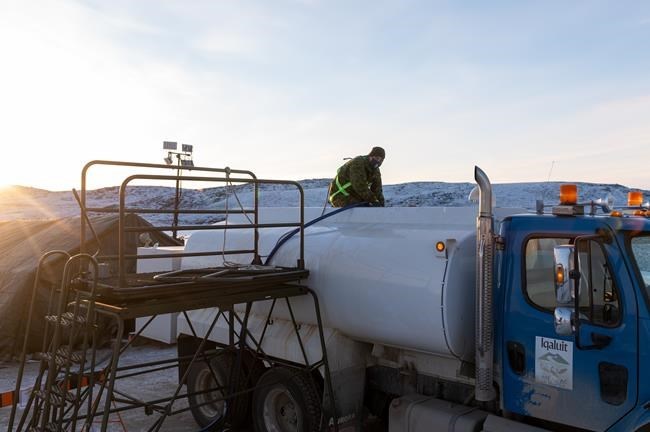IQALUIT, Nunavut — A flowing river that turns to solid ice in October, freezing pipes and frosty arctic temperatures are all routine for Nunavummiut.
But those issues were a first for a water treatment system previously used by the Canadian Armed Forces in places, including Haiti after the 2010 earthquake and the Philippines.
Iqaluit has been under a state of emergency since Oct. 12 when fuel was found in the water at the city's treatment plant. Residents have not been able to drink tap water since then.
The city has said that fuel from an old underground spill near the treatment plant may have leaked into the water system
Twenty-four members of the military arrived in Iqaluit on Oct. 23 at the request of the Nunavut government, but the military's water treatment system only started running on Tuesday.
Sgt. Matthew Dimma said it's the first time it's been used so far north.
"From hoses freezing, to pumps freezing, to valves freezing, everything just is severely affected by the cold," he said in an interview during a tour of the site Wednesday.
The system uses reverse osmosis to remove contaminants. It draws water from the Sylvia Grinnell River, just outside Iqaluit, and pumps it into treatment machines where it's pressurized and sent through a series of progressively smaller filters.
The water is then stored in heated tents in 11,000-litre bladders, which look like giant waterbeds, before it is pumped into the city's water trucks.
"We've had to break the ice. We've had to pump water into these bladders, heat these bladders, then ... process it into clean drinking water," Dimma explained.
He said the water is safe to drink right away and doesn't need to be boiled. On Tuesday, the military distributed 22,000 litres in Iqaluit.
Until recently, residents collected river water, which needed to be boiled, or picked up bottled water flown in by the Nunavut government and other organizations.
Dimma said the system was originally designed to be used in temperatures above four degrees Celsius. Temperatures in Iqaluit are hovering around -15 C these days.
"As you can probably imagine, the water temperature is significantly colder than four degrees," Dimma said as he pointed to the frozen river.
The team, he said, has had to break the ice on the river and switch out hoses because they keep freezing.
"We have to find the deepest spot to draw the water."
Once it is up and running, the system can pump 500 litres of water per minute into a truck. It takes about half an hour to fill one truck.
Water stations have been set up at two spots in the city for residents to collect what they need.
Dimma said access to equipment has made the military's operations in Iqaluit difficult. Most tools and replacement parts need to be flown up, which has caused delays.
He said there are lessons to be learned from the military using a system in Iqaluit that was not designed for cold weather.
"Hopefully we can further develop our Arctic capabilities in regards to (this) operation."
The military is scheduled to stay in Iqaluit and run the system until Wednesday, but Dimma said members would stay longer if needed.
The city has said that its testing of Iqaluit's water is now coming back clean. A report on the water quality has been submitted to Nunavut's Department of Health.
The department has hired a third party to review the report and a final assessment will be made on whether the water is safe to drink again.
This report by The Canadian Press was first published Nov. 11, 2021.
___
This story was produced with the financial assistance of the Facebook and Canadian Press News Fellowship.
Emma Tranter, The Canadian Press



